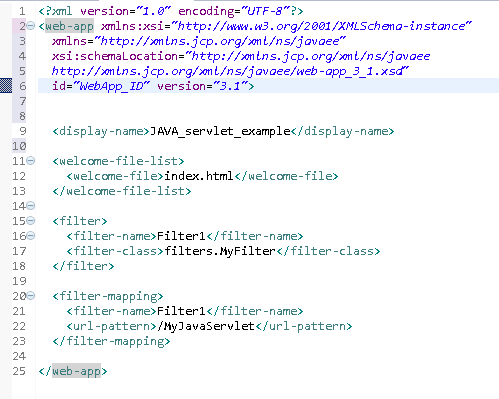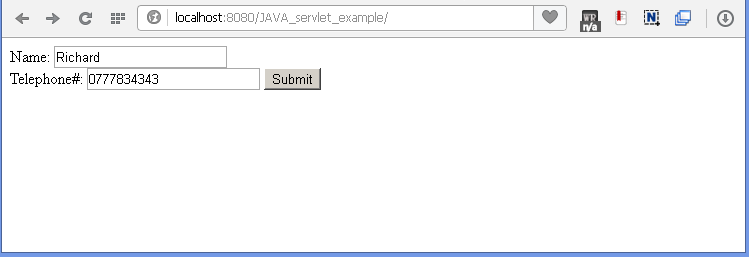#
Java Filter for logging
This tutorial will provide you with a short example where a Java Filter logs the incoming requests.
Servlet Filters are Java classes that can be used for intercepting requests from a client before they access a resource and for manipulating responses from server before they are sent back to the client. Filters perform filtering in the doFilter method. Every Filter has access to a FilterConfig object from which it can obtain its initialization parameters.
In the following example I will intercept a request and I will audit MyJavaServlet calls.
First, you have to create an HTML page. Let's define it as an index page into the Web Dynamic Project:
<!DOCTYPE html>
<html>
<head>
<meta charset="ISO-8859-1">
<title>From this page you call a Java servlet using POST Method</title>
</head>
<body>
<form action="MyJavaServlet" method="POST">
Name: <input type="text" name="name"> <br />
Telephone#: <input type="text" name="telephone" />
<input type="submit" value="Submit" />
</form>
</body>
</html>Here is the web.xml file:

NOTES:
- the name of the filter is not important for the configuration of the filter, but is important to understand why is created.
- url-pattern tag is used to activate that filter for the Servlets that fit to that URL pattern.
- filter-class tag is used to point to the class (code) that implement that filter.
- if 2 filters will apply to a Servlet the order will be established by the filter mapping order in the web.xml file.
- the Filters could be added or removed without changing the existing Java code.
And here is the code (the example) of my Java servlet which respond to a POST Method call :
package servlets;
import java.io.IOException;
import java.io.PrintWriter;
import javax.servlet.ServletException;
import javax.servlet.annotation.WebServlet;
import javax.servlet.http.HttpServlet;
import javax.servlet.http.HttpServletRequest;
import javax.servlet.http.HttpServletResponse;
/**
* Servlet implementation class MyJavaServlet
*/
@WebServlet("/MyJavaServlet")
public class MyJavaServlet extends HttpServlet {
private static final long serialVersionUID = 1L;
/**
* @see HttpServlet#HttpServlet()
*/
public MyJavaServlet() {
super();
// TODO Auto-generated constructor stub
}
/**
* @see HttpServlet#doPost(HttpServletRequest request, HttpServletResponse response)
*/
protected void doPost(HttpServletRequest request, HttpServletResponse response) throws ServletException, IOException {
// TODO Auto-generated method stub
PrintWriter myResponse = response.getWriter();
String message = "This is your response from a POST call. <br> The response is a Java Servlet !";
myResponse.println( "\n" +"<title> Example of using Java Servlet with POST Call Method !</title>\n" +
"\n" +
"<h2 align="\"center\"">" + message + "</h2>\n" +
"<ul>\n" +
" <li><b>You entered the name </b>: " + request.getParameter("name") + "\n" +
" </li><li><b>You entered the telephone# </b>: " + request.getParameter("telephone") + "\n" +
"</li></ul>\n" +
"");
}
}And here is the code of the Java Filter :
package filters;
import java.io.IOException;
import java.io.PrintWriter;
import java.util.Date;
import javax.servlet.Filter;
import javax.servlet.FilterChain;
import javax.servlet.FilterConfig;
import javax.servlet.ServletException;
import javax.servlet.ServletRequest;
import javax.servlet.ServletResponse;
import javax.servlet.annotation.WebFilter;
import javax.servlet.http.HttpServletRequest;
/**
* Servlet Filter implementation class MyFilter
*/
@WebFilter("/MyFilter")
public class MyFilter implements Filter {
/**
* Default constructor.
*/
public MyFilter() {
// TODO Auto-generated constructor stub
}
/**
* @see Filter#destroy()
*/
public void destroy() {
// TODO Auto-generated method stub
}
/**
* @see Filter#doFilter(ServletRequest, ServletResponse, FilterChain)
*/
public void doFilter(ServletRequest request, ServletResponse response, FilterChain chain) throws IOException, ServletException {
// TODO Auto-generated method stub
// place your code here
HttpServletRequest req = (HttpServletRequest) request;
String servletPath = req.getServletPath();
String remoteAddr = request.getRemoteAddr();
System.out.println(" ");
System.out.println("Logging Date: " + new Date());
System.out.println("Servlet path: " + servletPath );
System.out.println("Call from : " + remoteAddr);
// pass the request along the filter chain
chain.doFilter(request, response);
}
/**
* @see Filter#init(FilterConfig)
*/
public void init(FilterConfig fConfig) throws ServletException {
// TODO Auto-generated method stub
}
}When you run the index page you will see :

And when you press the "Submit" button you will see the page generated by the servlet :

Take a look into the console content (messages) and you will see:

Info
Logging into the console is not all the time a good choice. You might want to log into a log file for debug, auditing, etc.

